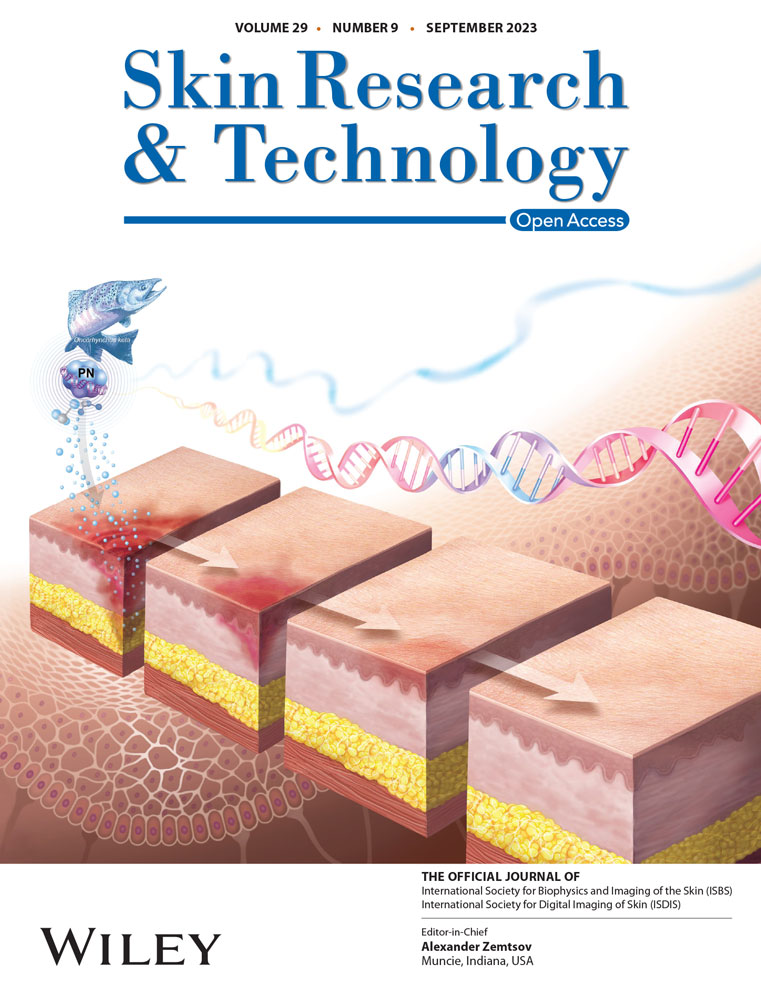Treatment of plane warts with long pulse ND – YAG laser 532 nm
Abstract
Background
Warts are one of the contagious viral diseases that may cause disturbing cosmetic problems. Plane warts represents a common self-limiting viral infection of the skin caused by the Human Papilloma Virus, however, those that do not disappear by themselves can be very difficult to treat with no uniformly effective treatment modality.
Objective
To assess the efficacy of long pulsed 532 nm ND:YAG laser in the treatment of plane warts.
Patients and Methods
In this therapeutic clinical trial study, 34 patients with plane warts were enrolled. Each patient was eligible for up to three treatment sessions administrated at 2 weeks intervals with long pulsed ND:YAG laser at a spot size 3 mm; wavelength 532 nm; pulsed duration 20 ms; and fluence 30 J/cm2. The patients were assessed before each treatment session and at 3 months after the last treatment session.
The response to treatment was graded using four points scale:
Scale 1 = poor: <25%,
Scale 2 = fair: 25%–50%,
Scale 3 = good: 51%–75%,
Scale 4 = excellent: >75%.
Results
Twenty-two patients only with a total of 478 lesions, completed the study; their ages ranged from (6–45) years with a mean ± SD 19.95 ± 13.142 years. Thirteen patients (59.09%) were female and nine (40.90%) were male. The results from this study showing that long pulsed ND:YAG laser 532 nm led to an excellent response in 19 patients (86.36%) in which 15 of 19 patients showed a complete response (78.94%); one patient showed a good response (4.545%), one showed a fair response (4.545%) and one showed a poor response (4.545%) at the end of three-months follow up. The difference was statistically significant; the P value at the three months follow-up was 0.002. The cumulative clearance rate after the first, second, and third treatment sessions was 58.4%, 77.7%, and 89.9% respectively. Recurrence was seen in only one patient (4.545%). Side effects were generally mild and didn't prevent normal activity.
Conclusion
Long pulsed ND:YAG laser 532 nm appears to be an effective method for treatment of plane warts.
1 INTRODUCTION
Warts are benign overgrowth of the epithelia of the skin and mucosa that develop secondary to infection with human papilloma viruses (HPVs).1 These viruses induce slow focal expansion of infected keratinocytes rather than acute signs or symptoms.2 HPV includes a diverse group of approximately 120 genotypes with different clinical types.
Verruca plana is one of the common types that affect mostly, children and young adults.2, 3 They appear smooth, flat, or slightly raised, with brown or skin color, slightly erythematous or grayish yellow, but may be pigmented. They are usually round or polygonal in shape with small sizes of 1–5 mm or more in diameter. The lesions are usually asymptomatic.3, 4 The face and extremities are the most common affected sites, especially the forehead, cheeks, nose, and particularly the area around the mouth and the backs of the hands, but the lesions can occur anywhere, including the neck, wrists, elbows, or knees5 and on shaved areas such as the beard area in men and the lower legs in women. There may be only a few, but in general, they are numerous.6 They are often grouped or in lines induced by koebnerization that form linear, slightly raised, popular lesions.4
Although they may disappear spontaneously upon the change in the immune system make it able to overcome the virus, the time taken may varies from few months to years.5 Resolution of the lesions is usually associated with pruritus, erythematous, and edematous appearance, depigmented haloes,7 and sudden appearance of multiple very small plane warts.8 The lesions may resolve completely within one month (when inflamed).4 Therefore, it is advised to watch for new warts, as treatment does not decrease the transmissibility of the virus.9 However, many patients request treatment due to social stigma or cosmetic nuisance.10
There are many modalities for the treatment of plane warts, but no single method is uniformly effective for all patients or directly antiviral.1 The form of therapy used depends on the number, site, type and size of lesions, age, and cooperation of the patients, pain inconvenience, duration, cost, cosmetic outcomes, risk of scarring, and previous treatments used and their success and failure.1, 4, 5 According to these factors, we have topical, physical and systemic treatments.
Most of these traditional methods of treatment have drawback and side effects. Surgical methods give good results, However, it may associated with pain and long recovery periods. The recurrence rate is high due to incomplete and superficial results, in addition to the risk of scarring, which is a serious complication, considering the fact that most of the lesions occur on the face of females.9 Long periods of application are usually needed on using topical management making the treatment success highly dependent on patient compliance.10
Lasers can be an alternative treatment choice for untreated and recalcitrant warts.11 The most commonly used laser modalities for the treatment of warts were the ablative lasers especially the carbon dioxide and Er:YAG lasers. They remove the virally infected epidermis layer by layer.8 Recently, the long-pulsed (LP) 1064 nm Nd:YAG laser, as a non-ablative type, has shown good results in the treatment of palmoplantar warts.1, 7, 12-14 It works by targeting the blood vessels in the dermis leading to interference with nutrition of the infected cells leading to their destruction.7
This prospective study evaluates the efficacy of LP Nd:YAG treatment for patients with plane wart. It was used previously in treating plantar warts with promising results.14 The dose of laser irradiation and the frequency of treatment is decided according to previous personal experience. We hypothesize that targeting the blood vessels supplying the wart tissue may lead to their clearance.
2 PATIENTS AND METHODS
This clinical interventional study was done in the Laser Research Unit of Dermatology, College of Medicine, University of Kufa from October 2021 to October 2022. The study was approved ethically by the Scientific Council of Dermatology and Venereology, Iraqi Board of Medical Specializations. The current work was designed to assess the effectiveness of long pulsed 532 nm ND:YAG laser in the treatment of verruca plana.
2.1 Patient selection
Patients with clinical features of verruca plana, single or multiple, were enrolled. They were recruited from the outpatient dermatology clinic of Al-Sadr Medical City. Thirty-four patients were included in the study, twelve of them defaulted for various reasons mostly as a drawback of the COVID19 pandemic or because the treatment session interfered with their work. So, twenty-two patients (nine males and 13 females) completed the study with a total of 478 verruca plana lesions. Their age ranged from 8 to 45 years.
Any patient who use of topical treatment for wart lesions or undergone physical destruction of the lesions in the past month such as surgical excision electrodessication, cryosurgery, or laser in the past month was excluded from the study. The other exclusion criteria included anticoagulant drugs administration, Pregnant and lactating women, and children under the age of 8 years.
2.2 Treatment
The procedure was fully explained to the patients or their parents along with the need of pre and post treatment photographs. A written informed consent was signed by all patients or their parents.
2.2.1 Preoperatively
Topical anesthetic (lidocaine 5% gel) was applied under occlusion for 30 min.
2.2.2 Intraoperatively
After cleaning the affected area with ethyl alcohol 96% solution, the laser beam was applied perpendicularly to each lesion. The study was carried out using a 532 nm long-pulsed Nd:YAG laser (Quanta System, Milan, Italy). The used parameters were as follow: spot size 3 mm; pulse duration 20 ms; and fluence 30 J/cm2. In each session, one or two passes of laser pulses with slight overlap were applied to each lesion, irradiating the lesion and a 1–2 mm of the surrounding area. The endpoint of the treatment was light grayish discoloration of the lesion. The number of treatment sessions was three sessions at 2 weeks interval or upon complete disappearance of the lesion. The patients were warned that the lesions could be tender and / or turn black and necrotic.
2.2.3 Post operatively
Topical antibiotic (2% fusidic acid cream) was applied on the treated sites, twice daily for 1–2 weeks to prevent secondary bacterial infections. Sunscreen with a sun protection factor of 50 was used throughout the study period to prevent post inflammatory hyperpigmentation.
3 EVALUATION
The patients evaluation was performed prior to all treatment sessions and three months after the last session. Treatment effect was objectively and subjectively assessed using the following methods:
3.1 Objective methods
-
The wart count was obtained by calculating the number of warts at baseline, before each treatment session, and at the end of follow up then evaluating the degree of reduction in wart counts and the response rate. The response was graded using a four-point scale:
- Scale 1 = poor: <25%.
- Scale 2 = fair: 25%−50%.
- Scale 3 = good: 51%−75%.
- Scale 4 = excellent: >75%.12
-
Photographic evaluation using a visual analogue scale. Color photographs were obtained for all patients at the beginning of the study, prior to each treatment session, and 3 months after the last session. Photographs were gained for each site in the same place with identical lighting and distance using Sonny digital, high sensitivity, 7.2 megapixels, DSC-W120 Cyper Shot.
3.2 Subjective methods
3.2.1 Patient satisfaction
- Grade 0: not satisfied (<25%).
- Grade 1: moderately or partially satisfied (25%–50%).
- Grade 2: very, but not fully satisfied (51%–75%).
- Grade 3: fully or completely satisfied (>75%).
The main adverse effects reported by the patients were pain, swelling, blisters, bruising, and breakdown of the treated area. Secondary bacterial infection, hyperpigmentation, hypopigmentation, and scarring, or any other visible side effect were looked for at each visit.
3.2.2 Statistical analysis
The SPSS program version 20 was used to analyze the collected data. Categorical variables were expressed as frequencies and percentages, while continuous variables were shown as mean ± SD. The relationships between categorical variables such as patient satisfaction, response, number of lesions, and VAS was assessed using Chi-square and Fisher’s exact tests. The Student's t-test was utilized for comparing the mean of the lesions at baseline and after each session. P-value equal to or less than 0.05 defining the significant statistical difference.
4 RESULTS
Twenty-two patients with a total of 478 lesions finished the treatment and follow-up period; their age ranged from 6 to 45 years with a mean ± SD 19.95 ± 13.142 years. Thirteen patients (59.09%) were female and nine (40.90%) were male. Twelve patients defaulted during the treatment periods. The duration of warts ranged from 1–36 months with a mean ± SD 9.3182 ± 7.88843 months (Table 1). The main affected sites were the face, neck, and upper extremities.
| Variable | No. | (%) | |
|---|---|---|---|
| Sex | Male | 9 | 40.9 |
| Female | 13 | 59.1 | |
| Age group (years) | 6–18 | 15 | 68.2 |
| 19–45 | 7 | 31.8 | |
| Mean age | 19.95 ± 13.142 | ||
| Marital status | Married | 6 | 27.3 |
| Not | 16 | 72.7 | |
| Previous history | Yes | 6 | 27.3 |
| No | 16 | 72.7 | |
| Skin type | II | 1 | 4.5 |
| III | 20 | 90.9 | |
| IV | 1 | 4.5 | |
| Duration | Less than 12 months | 13 | 59.1 |
| 12 months and above | 9 | 40.9 | |
| Mean duration | 9.3182 ± 7.88843 |
The enrolled patients need 1–3 treatment sessions on clearance of the lesions. Nineteen patients showed an excellent response (86.36%); one patient showed a good response (4.545%), one showed a fair response (4.545%), and one showed a poor response (4.545%) at the three-months after the last treatment session visit (Figure 1). Statistically the difference was significant; the P value at the three months follow up was 0.002. The cumulative clearance rate after the first, second and third treatment sessions was 58.4%, 77.7%, and 89.9% respectively (Table 2). The treated wart gets necrosis and shedded as a dry crust after 7–10 days, giving rise to a pink area that get normal skin color after average 3–4 weeks. Recurrence was observed in only one patient (4.545%). The rate of the response is not significantly affected by the age and sex of the patients, the presence or absence of previous treatment, or the site, number, duration, and color of the lesions (Tables 3–7). The photo micrographic documentations are shown in (Figures 2-5). Twenty-two (68.18%) patients were fully or completely satisfied and four (18.18%) were greatly satisfied (Figure 6).

| Session | Mean/warts no. | Std. Deviation/warts no. | Difference | P value | % reduction |
|---|---|---|---|---|---|
| Baseline | 21.7 | 27.02764 | 12.7 | 0.0001 | 58.4% |
| 2 weeks | 9.05 | 17.55122 | |||
| Baseline | 21.7 | 27.02764 | 16.9 | 0.001 | 77.7% |
| 4 weeks | 4.9 | 7.97792 | |||
| Baseline | 21.7 | 27.02764 | 19.5 | 0.002 | 89.9% |
| 6 weeks | 2.3 | 3.93013 | |||
| Baseline | 21.7 | 27.02764 | 19.2 | 0.002 | 88.5% |
| After 3 months | 2.5 | 4.61622 |
| Cross tab | ||||||
|---|---|---|---|---|---|---|
| Response after 3 months | ||||||
| Previous therapy | Excellent | Good | Moderate | Poor | Total | |
| yes | No. of patients | 6 | 0 | 0 | 0 | 6 |
| % | 100.0% | 0.0% | 0.0% | 0.0% | 100.0% | |
| no | No. of patients | 13 | 1 | 1 | 1 | 16 |
| % | 81.2% | 6.2% | 6.2% | 6.2% | 100.0% | |
| Total | No. of patients | 19 | 1 | 1 | 1 | 22 |
| % | 86.4% | 4.5% | 4.5% | 4.5% | 100.0% | |
- P = 0.7.
| Response after 3 months | ||||||
|---|---|---|---|---|---|---|
| Duration | Excellent | Good | Moderate | Poor | Total | |
| less than 12 months | No. of patients | 12 | 0 | 1 | 0 | 13 |
| % | 92.3% | 0.0% | 7.7% | 0.0% | 100.0% | |
| 12 months and above | No. of patients | 7 | 1 | 0 | 1 | 9 |
| % | 77.8% | 11.1% | 0.0% | 11.1% | 100.0% | |
| Total | No. of patients | 19 | 1 | 1 | 1 | 22 |
| % | 86.4% | 4.5% | 4.5% | 4.5% | 100.0% | |
- P = 0.3.
| Site 2a response after 3 months cross tabulation | |||||||
|---|---|---|---|---|---|---|---|
| Response after 3 months | |||||||
| Sites | Excellent | Good | Fair | Poor | Total | ||
| Face | Count | 16 | 0 | 1 | 0 | 17 | |
| % within Site | 94.1% | 0.0% | 5.9% | 0.0% | 100.0% | ||
| Neck | Count | 0 | 1 | 0 | 0 | 1 | |
| % within Site | 0.0% | 100.0% | 0.0% | 0.0% | 100.0% | ||
| Upper limb | Count | 1 | 0 | 0 | 1 | 2 | |
| % within Site | 50.0% | 0.0% | 0.0% | 50.0% | 100.0% | ||
| Multiple sitesa | Count | 2 | 0 | 0 | 0 | 2 | |
| % within Site | 100.0% | 0.0% | 0.0% | 0.0% | 100.0% | ||
| Total | Count | 19 | 1 | 1 | 1 | 22 | |
| % within Site | 86.4% | 4.5% | 4.5% | 4.5% | 100.0% | ||
- P = 0.001.
- a Multiple sites: face & neck , face & hand.
| Warts count * response after 3 months cross tabulation | |||||||
|---|---|---|---|---|---|---|---|
| Response after 3 months | |||||||
| Excellent | Good | Fair | Poor | Total | |||
| Warts count | ≤20 | No. | 12 | 0 | 0 | 1 | 13 |
| % within warts count | 92.3% | 0.0% | 0.0% | 7.7% | 100.0% | ||
| > 20 | No. | 7 | 1 | 1 | 0 | 9 | |
| % within warts count | 77.8% | 11.1% | 11.1% | 0.0% | 100.0% | ||
| Total | No. | 19 | 1 | 1 | 1 | 22 | |
| % within warts count | 86.4% | 4.5% | 4.5% | 4.5% | 100.0% | ||
- P = 0.3.
| Color * response after 3 months cross tabulation | |||||||
|---|---|---|---|---|---|---|---|
| Response after 3 months | |||||||
| Excellent | Good | Fair | Poor | Total | |||
| Color | Hyperpigmented | Count | 3 | 0 | 1 | 0 | 4 |
| % within color | 75.0% | 0.0% | 25.0% | 0.0% | 100.0% | ||
| Pink | Count | 1 | 0 | 0 | 0 | 1 | |
| % within color | 100.0% | 0.0% | 0.0% | 0.0% | 100.0% | ||
| Skin coloured | Count | 13 | 1 | 0 | 1 | 15 | |
| % within color | 86.7% | 6.7% | 0.0% | 6.7% | 100.0% | ||
| Hypopigmented | Count | 2 | 0 | 0 | 0 | 2 | |
| % within color | 100.0% | 0.0% | 0.0% | 0.0% | 100.0% | ||
| Total | Count | 19 | 1 | 1 | 1 | 22 | |
| % within color | 86.4% | 4.5% | 4.5% | 4.5% | 100.0% | ||
- P = 0.8.
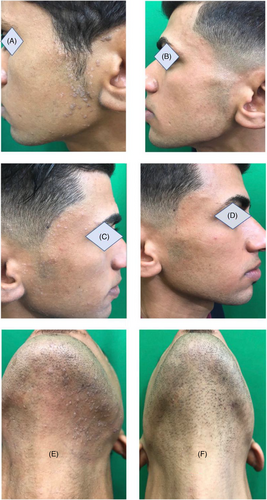
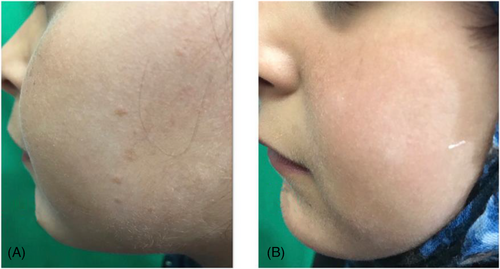
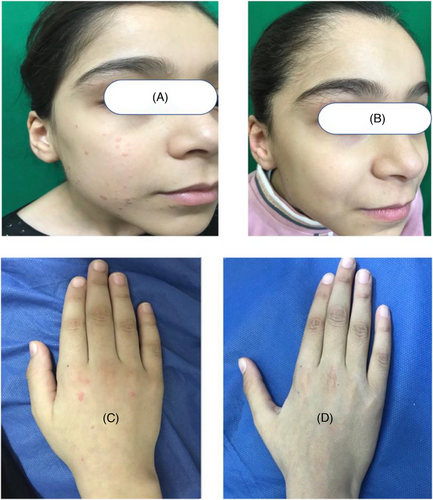
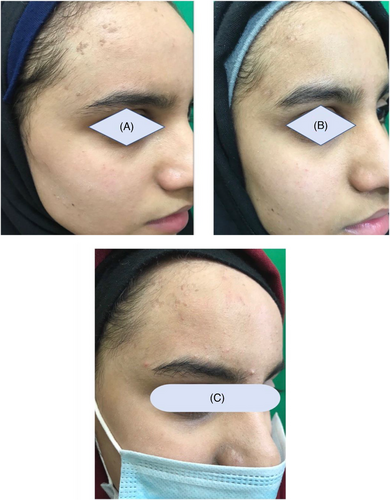
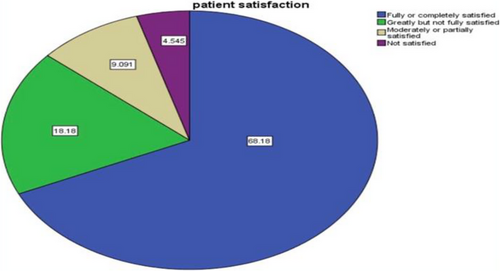
At the end of the therapeutic intervention, no significant side effects were reported. They were mild and did not affect the daily activity, including transient burning pain or minimal heat sensation experienced especially in children during treatment; Focal post-inflammatory hyperpigmentation of treated sites was reported in two patients (9.09%), however, it resolved gradually and disappeared without the need for any topical medication apart from sunscreen. No permanent side effects or scarring were detected during the follow-up period.
5 DISCUSSION
Plane warts are benign proliferation of the skin that result from infection with the human papilloma virus (HPV). They are often difficult to treat, bearing in mind that most of the cases affect the face of young people.
There are diverse methods of therapy, indicating that none is directly antiviral. Topical treatments and physical destruction treatment methods, each, have their own drawback of long duration and patient compliance dependence to the possibility of high recurrence rates or disfiguring hyperpigmentation or permanent scars on the face.5, 12 Ideally, treatment should be simple with the least risk of unwanted effects.13
Laser therapy has been used more frequently in recent years to treat viral warts. Ablative lasers such as Er:YAG and CO2 lasers, and non-ablative lasers such as long-pulsed Nd:YAG laser and PDL laser, are among the laser types that have been used to get rid of recalcitrant viral warts.1-3, 6, 8, 12-25 The mode of action of a long-pulsed Nd:YAG laser in the eradication of warts is not fully explained. As this laser targets oxyhemoglobin, as a chromophore, it can occlude dilated vessels in the papillary dermis, by selective photo thermolysis, obliterating the supply of nutrient to the infected tissue or destroying the instantly proliferating keratinocytes infected with the virus.14, 15 This may occur through coagulation (photothermal effect) or blasting (photomechanical effect) of the target tissue according to the pulse duration and the fluence used.13 A dense inflammatory infiltrate was found around the damaged blood vessels in the dermis.16-18 Remission with no recurrence in several case reports and case series has been associated with treatment by hyperthermia, which is usually associated with laser treatment.14-17 The HPV-infected tissue is found to be more affected by higher temperatures than normal tissue. Apoptosis and immune activation after exposure to a temperature of 39−44°C may lead to the removal of HPV infected keratinocytes and the surrounding cells.26 This additional effect of Nd:YAG on the virus itself and the wart tissue make it a good choice of treatment.18 Langerhans cells in the epidermis induced to get migrational maturation upon laser irradiation, generating an immune response. These cells can regenerate every two weeks with epidermal turnover every 52−75 days.26 This explain why laser treatments can be applied every two weeks and expecting the optimal response after 3 months. The main limitation of Nd:YAG laser treatment of plane wart is the need of multiple sessions,19, 20 and the previous studies showed a clearance rate of 14–22% the first session.3, 21
In the present study, 22 Iraqi patients (thirteen females and nine males) with a total of 478 lesions of plane wart were completed the treatment with long pulsed ND:YAG laser (532 nm, 3 mm spot size, 30 J/cm2 fluence, 20 ms pulsed duration). The results of the current work show that the long pulsed ND:YAG laser leads to an excellent response in nineteen patients (86.36%) in which fifteen of nineteen patients showed a complete response (78.94%); one patient showed a good response (4.545%), one showed a fair response (4.545%) and one showed a poor response (4.545%) at the end of three-months follow-up. Statistically, the difference was significant; P value at the end of follow up period was 0.002. The cumulative clearance rate after the first, second and third treatment sessions was 58.4%, 77.7% and 89.9%, respectively. Recurrence was observed in only one patient (4.545%).
Alshami et al. reported the largest study of plane warts treated with a long pulse Nd:YAG laser, which includes 160 Yameni patients using laser parameters: wavelength 532 nm; pulse duration 20 ms; spot size 2 mm; Fluence 25 j cm.22 The overall clearance rate was (92%), slightly higher than the response rate of the present study (86.45%). They were found that the duration of the warts was affect the response rate as the response was decreased with increasing the duration of warts (98%), cure rate for lesions less than 7 months compared to 84% for lesions older than 2 years, however, in this study, it was found that the duration of the warts has no statistically significant association with the response rate (p value 0.3).
Similarly, a decline in response rate with an increase in warts number was revealed, however, the present study shows an insignificant association between warts counts and the response rate (p value 0.566).
Alshami et al. study was done on facial lesions only, however, the present study in addition to the face included the neck, hand, forearm. In the present study, we evaluate the relation between the color of warts and the response rate however P value was not signifacant (0.8)
Ashraf Badawi et al. evaluated the effectiveness of long pulse 1064 nm in treatment of plane warts. They found that the complete response was (83.3%) slightly less than the cure rate of the present study (86.36%). They attributed the high effectiveness of 1064 nm Nd:YAG laser to its deep penetration into the tissue: however, this can also make the procedure relatively painful.23
Khandpur et al. found that the treatment of warts with PDL has been found to give comparable cure rate to conventional modalities (cure rate: 56%−80%); Although, it gives the advantage of a better response in recalcitrant lesions, a low recurrence rate, a low complication profile, and better compliance, as it is applied every 3−4 weeks.24
Balevi et al. evaluated the Erbium -YAG laser in the treatment of 46 patients with recalcitrant plane wart on the face. Complete response rate seen in (83.3%), less than the present study response rate (86.3%) and with more side effects (scarring and pigment change, or recurrence).25
Zemtsov A et.al. evaluated the Nd:Yag laser treatment of extensive recalcitrant anal condyloma acuminate by single session with good response rate.27
No wound was created upon treatment with a long-pulsed Nd-YAG laser in contrast with ablative treatment modalities. This feature leads to avoiding prolonged postoperative pain, scarring, or downtime, especially if the lesions were on exposed parts of the body, especially, the head and neck. The pulsed mode of the laser system is usually associated with less pain, and most of the treated patients returned to work or normal activities directly after the laser session.
So, current work demonstrated that long pulsed ND:YAG laser (532 nm) is an effective, well tolerated, with minimal complication method in the treatment of plane warts. It is apparent that a few sessions of laser are much easier for the patients than the daily use of topical treatment. Also, it shows a high success rate with fewer side effects when compared with ablative laser, cryotherapy, or electrocautery with high success rate.
6 CONCLUSION
Long pulsed ND:YAG laser (532 nm) seems to be an effective and well tolerated method in the treatment of plane warts.
ACKNOWLEDGMENT
The funding sources for the work are at the author's personal expense.
Open Research
DATA AVAILABILITY STATEMENT
The data that support the findings of this study are available from the corresponding author upon reasonable request.



